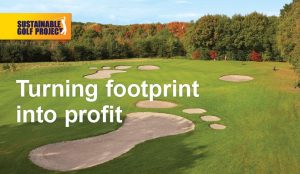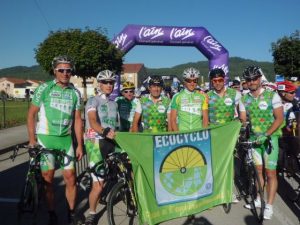This blog highlights and recognises some of the work that is already being done to utilise the unique power of sport to address environmental challenges.
By Michael Pedersen,
Founder of M INC. > change the game http://minc.ch.
The evidence provided within this text reflects information as at 22 September 2015.

Sport is uniquely placed to address societal challenges. It attracts unprecedented attention and unites people across traditional societal dividing lines such as religion, ethnicity, political observation, wealth, social class and cultures.
Greening sport events vs. greening fan behaviours
There are generally two ways for sport to address environmental challenges. One is to reduce the environmental footprint of sport. The other one is to motivate behavioral change among fans, inside as well as outside the stadium.
While most of the current work focuses on greening sport, there is a big potential in also utilising sport to motivate behavioural change among fans in support of addressing environmental challenges.
The environmental footprint of sport

Sport negatively impacts the environment in several ways. Its environmental footprint is primarily caused by (no particular order):
- The production and distribution of sports wear and sport equipment, including usage (washing clothe) and disposal (garbage).
- Construction of new sport venues for the hosting of sport events (or renovation of existing facilities).
- Construction of new public infrastructure for the hosting of very big sport events (or renovation of existing infrastructure).
- Fans engaging in sport tourism.
- Board members and professional staff of sport organisations traveling around the world to attend annual meetings, board meetings and other meetings of national and international sport governing bodies, leagues and clubs.
- Professional athletes traveling around the world to participate in training and to compete at sport events.
Emerging solutions in the world of sport
 While the International Olympic Committee [ http://www.olympic.org/sustainability-and-legacy-commission ] and FIFA [ http://www.fifa.com/sustainability ] are integrating environmental sustainability into their evaluation criteria for bidders to host their events, other international sport bodies like for instance International Ski Federation [ http://www.fis-ski.com/news-multimedia/news/article=prj-fissustainability.html ], Badminton World Federation [ http://www.bwfbadminton.org/page.aspx?id=22052 ] and International Motorcycling Federation [ http://www.fim-live.com/en/beyond-sport/topic/ride-green/ ] are putting in place environmental policies to guide events in their sports.
While the International Olympic Committee [ http://www.olympic.org/sustainability-and-legacy-commission ] and FIFA [ http://www.fifa.com/sustainability ] are integrating environmental sustainability into their evaluation criteria for bidders to host their events, other international sport bodies like for instance International Ski Federation [ http://www.fis-ski.com/news-multimedia/news/article=prj-fissustainability.html ], Badminton World Federation [ http://www.bwfbadminton.org/page.aspx?id=22052 ] and International Motorcycling Federation [ http://www.fim-live.com/en/beyond-sport/topic/ride-green/ ] are putting in place environmental policies to guide events in their sports.
In sports like for instance golf, surfing and sailing, specific organisations are being established to develop standards for greening sport specific events and/or sport specific equipment, i.e.


Sustainable Surf [ http://www.sustainablesurf.org ], Sailors for the Sea [ http://www.sailorsforthesea.org ] and Golf Environment Organization [ http://www.golfenvironment.org ].
Also, in countries such as the USA, United Kingdom and Australia, specific organizations that focus on sport and the environment across sports are being established,i.e. Green Sports Alliance, British Association for Sustainable Sport, and Sports Environmental Alliance. Last but not least, international standards and tools for greening of sport events are being created, i.e. by Académie Internationale des Sciences et Techniques du Sport (AISTS).
- http://www.greensportsalliance.org
- http://www.basis.org.uk
- http://hwww.sportsenvironmentalliance.org
- http://www.aists.org/sse
Evolving good practice: Environmental stewardship at the US Open in tennis
United States Tennis Association (USTA), which is the sport governing body that organises the US Open [ http://www.usopen.org/en_US/about/green_initiatives.html ], initiated its environmental work in the context of the US Open Tournament in 2008. Among other things, USTA’s strategic decision to do so reflected increasing fan expectations of green initiatives and burgeoning energy costs.
During recent years, USTA has further increased and diversified its initiatives to minimize the environmental impact of US Open. Today, the Association is showcasing environmental stewardship in the context of its annual premier Tournament in at least four ways:
Minimizing direct environmental impact
Initiatives to minimize the direct environmental impact of US Open include:
- Matching the electricity generated during the tournament through Green-e certified wind renewable energy certificates
- Using napkins and other paper material composed of 40-100 percent recycled material
- Diverting waste through recycling and composting
- Collecting tennis balls used during matches and practices to be donated to community and youth organisations
Off-setting the environmental impact of player travel
Player travel to US Open is offset through Green-e Climate certified Sterling Planet carbon offsets. That is the case for both travel by air as well as travel on the ground.
Encouraging fans to adopt environmentally responsible behaviour
Each year, USTA hosts more than 700,000 fans during the two weeks of US Open at The Billie Jean King National Tennis Center in New York City, USA. Initiatives to encourage tennis fans to adopt environmentally responsible behaviour include a campaign for them to take public transportation to the tournament venue.
Initiatives to encourage fans to adopt environmentally responsible behaviour beyond the US Open include a 30-second public service announcement titled “Impact”. Broadcasted regularly during the tournament, the announcement encourages fans to reduce their paper, water and energy use.
An important aspect is a message from Billie Jean King, the tennis legend whose name the stadium carries. Her message is: “To solve the serious environmental problems facing our planet, we need to shift our culture toward more sustainable practices.”
Other similar initiatives include environmental tips for smarter living that are featured in the ‘Daily Draw sheet’ as well as through US Open social media channels.
Shaping evolving good environmental practices in sport in partnership with others
Besides working closely with the Natural Resources Defense Council, USTA is a member of Green Sports Alliance.
Evolving good practice: International Cycling Union Eco Cyclo Patrol

The Eco Cyclo Patrol [ http://www.eco-cyclo.org ] was created in 2006 in France by a passionate cyclist named Patrick François.
After too many negative experiences in seeing what participants leave behind at cycling events, Patrick decided to recruit volunteer cyclists to teach good environmental manners to their fellow participants.
The easily recognizable Eco Cyclo Patrol group of volunteer cyclists participate in targeted cycling events with the mission of advising and encouraging their fellow cyclists to adopt a responsible attitude to the environment.
Dressed in easily recognizable green harlequin jerseys, the volunteers in the Eco Cyclo Patrol ride alongside their fellow cycling fans and encourage green behavior. Not only do they fight against rubbish left behind by participants after major cycling events, they also work with organizers to encourage the use of renewable energy and recyclable infrastructures.
In 2013, the Eco Cyclo Patrol gained support by the International Cycling Union and is now expanding to offer cyclists and event organisers all around the world the opportunity to join in adopting environmentally friendly practices too.
Conclusion
Sport is uniquely placed to address societal challenges such as environmental issues. It can reduce its environmental footprint, not least from sport events.
it is in a position to motivate behavioral change among fans in support of the environment, inside as well as outside the stadium.
Emerging solutions include integrating environmental sustainability into the evaluation criteria for bidders to host sport events as well as establishing sport or country specific organisations, offering guidance and standards to reduce the environmental impact of sport.
Cases of emerging good practice include the US Open in tennis and the International Cycling Union’s Eco Cyclo Patrol.


